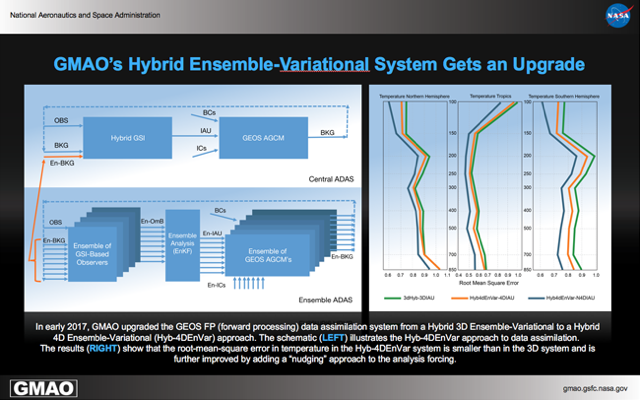GMAO's Hybrid Ensemble-Variational System Gets an Upgrade
In January 2017, GMAO introduced major upgrades into its Goddard Earth Observing System Forward-Processing (GEOS FP) data assimilation system. One major change is the introduction of the time dimension into the hybrid ensemble-variational data assimilation technique, thus transitioning from a three- to a four-dimensional system. Here, the impacts of using the Hybrid 4D-Ensemble Variational (Hyb-4DEnVar) approach are demonstrated by comparisons to the previous GEOS FP system, which used a Hyb-3DEnVar approach. These changes to the assimilation approach were introduced into GEOS FP along with some other major updates, including an increase in the spatial resolution of the system (that are not examined here).
A schematic view of the GEOS FP Hybrid Ensemble-Variational System illustrates that it includes two atmospheric data assimilation systems (ADASs) that run in parallel. The so-called central DAS is a (deterministic) hybrid 4DEnVar system, which includes an analysis and atmospheric general circulation model (AGCM) feeding off each other in a largely typical data assimilation cycle (see top grey area of the left-hand figure). The only difference between this and a traditional 3DVar system is that in the hybrid configuration, the central analysis uses an ensemble of background perturbations (red-arrows) to define a flow-dependent background error covariance.
This ensemble of background perturbations is generated by a parallel ensemble ADAS (lower grey area of schematic in the left-hand figure) that runs multiple instances of AGCM integrations. These integrations feed off of an ensemble of analyses performed as the ensemble ADAS cycles. In GEOS ADAS, the central hybrid analysis is produced using the Grid-point Statistical Interpolation system (GSI; Wu et al. 2002; Wang et al. 2013), and the ensemble analysis is generated using the ensemble square-root filter (EnSRF; Whitaker and Hamill 2002). Both of these analysis systems have been developed collaboratively by NOAA and NASA, partly under the auspices of the Joint Center for Satellite Data Assimilation and are adapted in this work to meet the requirements of GEOS FP.
Right: Root-mean-square error in temperature, averaged over three regions, of self-verified 36-hour forecasts for three configurations of the GMAO data assimilation system under evaluation for FP upgrade. The baseline hybrid 3DVar (3dHyb-3dIAU, similar to the FP configuration used until mid-January 2017), and two configurations of the hybrid 4DEnVar system using either 4DIAU or the newly introduced nudged-4DIAU (N4DIAU). Results are largely statically significant (not show) and highlight the improvements brought about by the 4D strategy over 3D, which are further enhanced when using the nudged 4DIAU approach.
In the experiments highlighted here, the Hyb-4DEnVar system uses a central ADAS with a 25-km resolution version of the GEOS AGCM, with the hybrid GSI analysis produced at 50 km. The 32-member ensemble operates at roughly 100 km (for both the AGCM and the analysis). The ensemble ADAS uses the incremental analysis update (IAU; Bloom et al. 1996) approach in its traditional 3D sense. The evaluation of the Hyb-4DEnVar system involves only differences in how the central ADAS is configured. The baseline Hybrid 3DVar generates an incremental correction to the state of the model in the middle of the 6-hour assimilation window. The correction is given to the high-resolution atmospheric model using the traditional (3D) Incremental Analysis Update (IAU) procedure.
In 4D procedures such as the hybrid 4DEnVar the analysis produces hourly incremental corrections to the model background. These corrections can be used in GEOS ADAS in two ways: as hourly piecewise constant 4D-IAU terms (e.g., Clayton et al. 2013; Zhang et al. 2015); or through a new approach, developed at GMAO, referred to as 4D nudged-IAU (4D-NIAU) where the hourly piecewise constant corrections are generated as the model state evolves by nudging its current state to the hourly analyses. Both 4D strategies, using 4D-IAU or 4D-NIAU, show as improvements over Hybrid 3DVar, with 4D-NIAU being considerable superior to 4D-IAU. An illustration of such improvements appears in the figure on the right.
The upgrade introduced in GEOS FP in January 2017 implements Hybrid 4DEnVar combines with the 4D-NIAU approach and an additional near halving of the horizontal resolution. In the production configuration, the central ADAS runs at 12.5 km and the ensemble members run at 50 km resolution. Additional refinements to the 4D-NIAU are being examined and these are expected to be even more effective means of making 4D corrections to the model integration. Future enhancements to the analysis approach will also involve upgrading the ensemble to generate members using a 4D approach similar to that used in the central ADAS.
References:
Bloom, S. C., L. L. Takacs, A. M. da Silva, and D. Ledvina, 1996: Data assimilation using incremental analysis updates. Mon. Wea. Rev., 124, 1256-1271.
Clayton A. M., Lorenc A. C., Barker D.M., 2013. Operational implementation of a hybrid ensemble/4D-Var global data assimilation system at the Met Office. QJR Meteorol. Soc., 139, 1445–1461.
Whitaker, J. S. and T. M. Hamill, 2002: Ensemble data assimilation with perturbed observations. Mon. Wea. Rev., 130, 1913-1924.
Wang, X., D. Parrish, D. Kleist, J. Whitaker, 2013: GSI 3DVar–Based Ensemble–Variational Hybrid Data Assimilation for NCEP Global Forecast System: Single-Resolution Experiments. Mon. Wea. Rev., 141, 4098-4117.
Wu, W. S., J. R. Purser, and D. F. Parrish, 2002: Three-dimensional variational analysis with specially inhomogeneous covariances. Mon. Wea. Rev., 130, 2905-2916. 0
Zhang, B., V. Tallapragada, F. Weng, J. Sippel, Z. Ma, 2015: Use of incremental analysis updates in 4D-Var data assimilation. Advances in Atmospheric Sciences, 32(12), 1575–1582.


